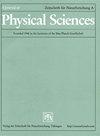人工智能方法分析n型和p型硅衬底中11B、31P和75As的SIMS谱:实验研究
IF 1.3
4区 物理与天体物理
Q4 CHEMISTRY, PHYSICAL
Zeitschrift Fur Naturforschung Section A-A Journal of Physical Sciences
Pub Date : 2023-10-20
DOI:10.1515/zna-2023-0200
引用次数: 0
摘要
摘要本文报道了一种基于人工智能技术的有效方法来研究硼、磷和砷离子的二次离子质谱(SIMS)谱。采用离子注入技术将这些掺杂离子注入到n型和p型(100)硅衬底中,注入能量分别为100和180 keV。在900 ~ 1030℃的不同温度下进行30 min的退火处理。采用粒子群优化(PSO)算法确定掺杂谱参数,如活化能、扩散系数、结深度、注入剂量、投影范围和标准差。实验结果表明,该策略的有效性得到了验证。此外,在不同退火时间下生成了一组模拟掺杂谱图,以证明该方法即使在改变实验条件下也能准确估计上述参数。本文章由计算机程序翻译,如有差异,请以英文原文为准。
Artificial intelligence approach to analyze SIMS profiles of 11B, 31P and 75As in n- and p-type silicon substrates: experimental investigation
Abstract In this work, we report an effective approach based on an artificial intelligence technique to investigate the secondary ions mass spectroscopy (SIMS) profiles of boron, phosphorus and arsenic ions. Those dopant ions were implanted into n- and p-type (100) Silicon substrate using the ion implantation technique with energy of 100 and 180 keV. Annealing treatment was conducted at various temperatures ranging from 900 to 1030 °C for 30 min. The doping profile parameters such as the activation energy, diffusion coefficient, junction depth, implant dose, projected range and standard deviation were determined using particle swarm optimization (PSO) algorithm. The efficiency of this strategy was experimentally verified by the fitting between both real measured SIMS profile and predicted ones. In addition, a set of simulated doping profiles was generated for different annealing time to prove the ability of this approach to accurately estimate the above parameters even when changing the experimental conditions.
求助全文
通过发布文献求助,成功后即可免费获取论文全文。
去求助
来源期刊
CiteScore
3.00
自引率
5.60%
发文量
81
审稿时长
3.3 months
期刊介绍:
A Journal of Physical Sciences: Zeitschrift für Naturforschung A (ZNA) is an international scientific journal which publishes original research papers from all areas of experimental and theoretical physics. Authors are encouraged to pay particular attention to a clear exposition of their respective subject, addressing a wide readership. In accordance with the name of our journal, which means “Journal for Natural Sciences”, manuscripts submitted to ZNA should have a tangible connection to actual physical phenomena. In particular, we welcome experiment-oriented contributions.

 求助内容:
求助内容: 应助结果提醒方式:
应助结果提醒方式:


